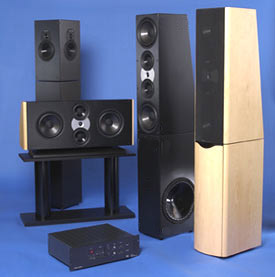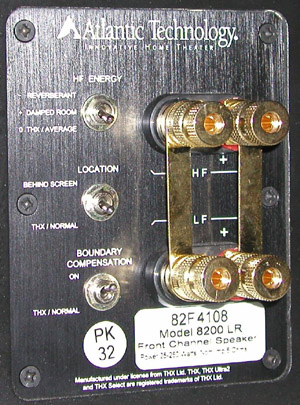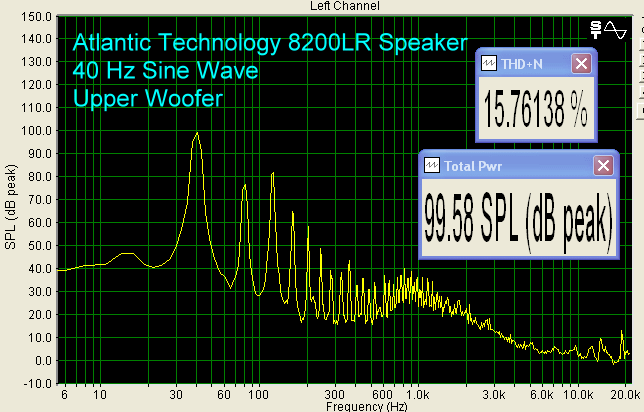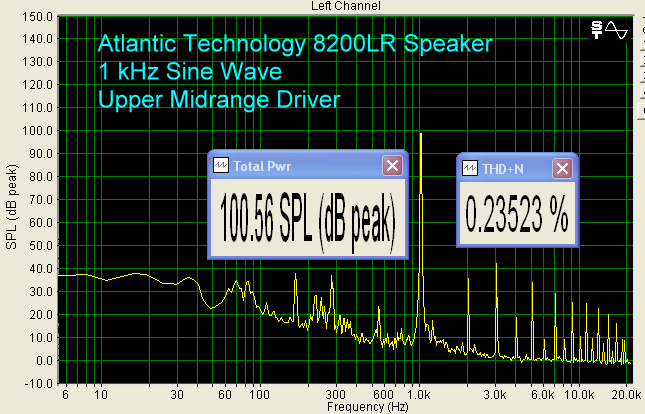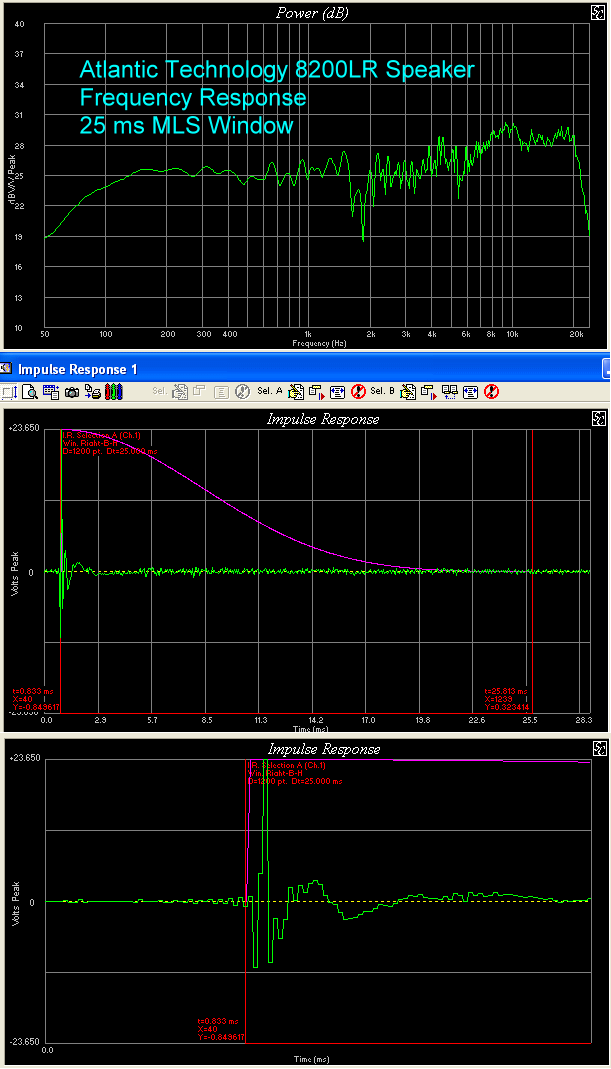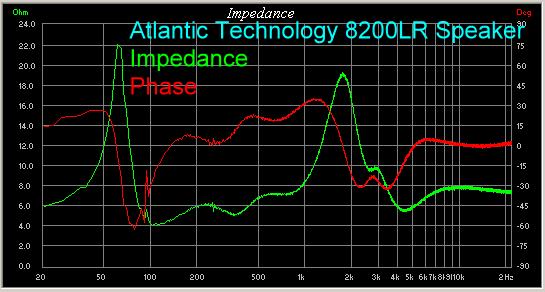|
|||||||||||||||||||||||||
|
Joyful Trouble When I received the system, my joy was tinged with angst. The total box count came in at 18, and I was supposed
to move them into my room. My immediate thought was, my back is going to
be sore tonight. But this thought was drowned by the excitement of
imagining the impact of four subwoofers (notwithstanding the fact that
four of
these particular subwoofers are required to meet THX requirements). This “joyful trouble” was going to
be worthwhile! For the sound, the system was required to be acoustically flexible. Controls would be provided to compensate for room and/or placement limitations. In fact, when I called Peter, his very first statement was, “Have you tweaked it?” When designing the acoustic controls, the design team had to identify the problem that each control might address. For example, when designing one such control, they measured the speaker response by re-locating the speaker to the middle of the room, placing it on a shelf, and also placing it besides a TV. The response from each location was averaged and analyzed. It was determined that reducing the energy between 100-200 Hz improved intelligibility. And thus was born the “Boundary Compensation” control. On the issue of aesthetics, the speakers were designed to
look good. Several finishes are available, and one can order unfinished
panels, which can then be custom finished.
The original THX specification laid great emphasis on limited vertical dispersion. This was to reduce the floor and ceiling reflections that would otherwise reduce intelligibility. While it is possible to acoustically treat a floor and ceiling to the same effect, the thought here is that it is easier to address the issue in the speaker, rather than undergo major renovations in a living room. The requirements were so strict though that in order to make this happen in a three-way speaker system, one had to push the drivers to their absolute limits, leading occasionally to suboptimal crossover designs (or go the way of M&K with their entirely unique two-way three tweeter configuration). In such systems, if you were not seated at the right height, the loudspeakers would not sound good. Limited vertical dispersion is still mandated by the THX Ultra2 specification; however, the parameters have been relaxed.
An interesting tidbit that I learned during the conversation was that the first sets of THX center channel speakers were not horizontal designs. People did not know how to design a horizontally configured center channel speaker that would meet THX specification. Peter was testing some THX speakers at his house one day when his wife walked in and commented, “I am not going to have a smoke stack in my living room.” The reference was to the vertical center channel design (have a look at the virtual room on Video Essentials to get the idea). The demand for “spouse acceptance factor” resulted in Atlantic Technology's design of the first horizontally configured center channel that met THX requirements! To read about THX Ultra2, refer to
Q&A #360. The 8200 LR main front channel speaker and the 8200 C center channel speaker
are three-way D' Appolito designs. Both speakers use two 8” woofers, two 5.25”
midrange drivers, and a 1” FerrofluidTM cooled,
damped silk dome tweeter with a neodymium magnet. The midrange and tweeter
drivers have their own sub-enclosure. The woofers on the center channel
are situated on either side of the tweeter. Both the front and center
channel speakers are magnetically shielded, so they can be placed close to
a TV. And both speakers have bi-wiring capability.
1. High Frequency Energy: Rooms with hardwood floors and bare walls will sound bright. On the other hand, if the room is over-damped, the speakers will sound dead. This control changes the tweeter slope. Three positions are provided: “- Reverberant”, “+ Damped Room” and “0 THX/Average”. 2. Location: If your speaker is located behind a perforated screen, for example, it is likely that the high frequencies will get attenuated. This control can be used to increase the upper midrange and high frequency response. There are two positions: “Behind Screen” and “THX/Normal”. 3. Boundary Compensation: If your room setup is such that the speaker must be situated close to a room boundary, you will get excess lower midrange output. This control can be used to reduce that excess. There are two positions: “On” and “THX/Normal”.
The 8200 SR (surround) speakers use two 6.5” woofers and two
of the same tweeters used in the main and center channel speakers. They can be
switched between Bipole and Dipole operation. THX mandates the use of
Dipole speakers for the side surrounds, however, there are some people who
like the sound of Bipoles when listening to music. In any case, I am glad
that this flexibility is present. The PedWoofers (Ped->Pedestal) can either be used as a "stand" for the main front channel speakers or off by themselves. There are threaded posts that screw to the top of the PedWoofer and the 8200 LR can slide into these posts. If used as a stand for the 8200 LR, Atlantic recommends having the drivers face the center of the room. The PedWoofers are marked left and right for this purpose, although there is nothing that prevents you from making them face the side walls. In fact for the rear surrounds, the 8200 LRs were so close to each other that I pointed the drivers towards the side walls. Spikes are provided that screw to the bottom of the PedWoofer. The pointed ends can be unscrewed if the speakers are to sit on hardwood floors.
Ultra2 qualification requires two pairs of PedWoofers (four units in all) to be used. A pair of PedWoofers can respond down to 20 Hz and achieve peak SPLs of 105 dB in a 3000 cubic foot room. Two pairs can of course meet the same requirements with lower distortion. Whether you need two pairs is something that you should determine based on your budget and room size. One issue that I had with the PedWoofers was that they served as stands for the 8200 LR, which limited placement options. For example, the Ultra2 spec requires the rear surrounds to be close together. This meant that the PedWoofers, which the surround speakers were mounted on, were located next to each other, and each PedWoofer was on either side of the midpoint of the rear wall. This is not an ideal position for the subwoofers. I would have preferred to have dedicated stands for the 8200 LR. This option is available and it is something that you might want to consider. I did not have stands to mount the 8200 LR on. What I tried instead were different placement options using the PedWoofers from the rear surrounds. With regards to placement options for multiple subwoofers, I highly recommend reading the white paper titled “Subwoofers: Optimum Number and Locations”. This paper can be downloaded HERE. I tried one of the recommended placements and got very good results. [Editor's Note: Indeed in our experience the best place for subwoofers is rarely coincident with the appropriate place for any of the main speakers so this whole subwoofer-as-a-speaker-stand thing is a little counter productive]
The PedWoofers are driven by the SA 8200 which is an external amplifier. The SA 8200 is a two-channel amplifier rated at 350 watts RMS/channel with servo-control. There is a four position phase switch (0, 90, 180 and 270). The low pass crossover frequency is continuously variable between 50 Hz and 150 Hz. The amplifier's crossover control can be bypassed by setting the control to “THX/ENT”. This would be the case when using a receiver or preamplifier's built-in crossover. Multiple SA 8200 amplifiers can be daisy-chained together, so that you can send one subwoofer signal to all the subwoofers if you like. Room modes are something that we all have to deal with. While judicious placement can help, there are times when parametric equalization is also needed to achieve flat bass response, without which the thunderous explosions might either sound underwhelming or boomy! The amplifier has a built-in single band parametric equalizer. The control parameters provided include the center frequency of the peak (selectable between 25 Hz - 125 Hz), the width around the peak to attenuate (0.2-1.5 octaves), and the amount by which to attenuate the peak (0 dB to -20 dB). There are also four preset equalization curves that can be selected based on the program material or preference. All the controls can be adjusted independently for each PedWoofer. The presets and level can be adjusted using the supplied remote control. I spent a good deal of time experimenting with these controls, the result of which was much improved bass response.
I would, however, like to see this progress into a multi-band equalization system. If you have a room mode frequency X Hz, then the room modes will also occur at integer multiples of that frequency; these modes also need to be attenuated. I would also like to see additional marking on the controls. For example, the frequency can be selected from 25 Hz - 125 Hz, however, only 25 Hz, 75 Hz, and 125 Hz are marked. In fact, having markings that correspond to the frequencies of the test tones on the test CD that is provided would be ideal. For the rears (a.k.a. center surrounds), I received the same set of speakers as the front: a pair of the 8200 LRs that sat on a pair of the 8200 Pedestal subwoofers. My only reservation for using these speakers as the rear surrounds is size and cost. My preference would be towards a smaller wall mountable solution. In fact, my preferred solution would allow for the 8200 SR to be operated in dual-drive mode. While this cannot be done at present, I hope that Atlantic considers this option. Another option would be to use the 6200 LRs which are smaller and less expensive. Of course, if you like big speakers all the way around, then four 8200 LRs would be suitable. All speakers including the PedWoofers have sealed enclosures. All speakers
except for the PedWoofers come with metal grilles that are held to the
enclosure with Neodymium magnets. I really enjoyed watching movies on this system. The battle scene in "Gladiator", the Omaha beach landing in "Saving Private Ryan", and the pod race in "Star Wars I" all sounded excellent. Gladiator has a DTS ES mix, and Star Wars has a Dolby Digital EX mix. The rear surrounds were quite active in these movies. With these speakers engaged, the sense of space behind me was more real than with just the two side surrounds, and the bass was always powerful and tight. The benefit of having multiple subwoofers was very evident. The system could play louder, if it had to, with lower distortion. The SA 8200 has circuitry that automatically activates the amplifier when it senses a signal, and switches it into standby mode if no signal is detected after 7-10 minutes. There were a few instances while watching movies where the amplifier went into standby mode. I would have liked a way to disable automatic activation/de-activation. [Editor's Note: We need to see Atlantic Technology work with THX to correct this. Since Sumit was using a THX SSP with predictable line level output voltage and impedance, this problem should not exist. The whole point of THX is products that work together]. In two channel mode, I used a pair of 8200 LRs mounted on a pair of PedWoofers. I set the crossover frequency to 80 Hz. The 8200 LRs were smooth through the midrange; male and female vocals sounded very good. The treble was bright, but I was able to reduce the brightness with the “High Frequency Energy” control. Detail was resolved well, but it was a touch shy of the very best that I have heard. The bass, as one might imagine, was excellent. The ability to attenuate a room mode via controls on the SA 8200 amplifier helped improve the bass definition. The system really shines when used as a whole. I found stereo recordings with DPL-II engaged very involving. And then there was the joy of listening to some wonderful surround music discs! While listening to the Blue Man Group DVD, I was able to crank up the volume to reasonably high levels without any audible distortion. My two favorite pieces on this disc are “Rods And Cones” and “Club Nowhere”, and they both sounded very dynamic. The sense of space created by the surrounds was just right. I also enjoyed listening to the DVD-Audio sampler from AIX records. One of the pieces on this disc is from an a cappella group called Zephyr. There is a stage and an audience mix. The former mix is recorded with the group standing in a circle with the microphone situated in the center. This piece is a good test for system coherence since vocals are reproduced through each speaker. The tonal balance of the system was very good. it also tested
voice articulation capabilities of the surround channels, which are
typically used to reproduce gimmicky sound effects in movies. The 8200
system excelled here. The tonal balance was wonderful. It felt as if the
group was around me. It was a private performance! Kudos to the recording
engineer, and kudos to the 8200 system for the faithful reproduction. On the Bench (JEJ) We tested the 8200 LR as representative of the system. At 40 Hz, which is below what the 8200 LRs are rated for, THD was high. They are meant to be crossed over at about 70 Hz.
At 50 Hz, THD was more manageable, but still on the high side.
At 100 Hz, the 8200 LR measured less than 1% THD.
At 1 kHz, using the upper midrange driver, there was less than 0.25% THD, which is very good.
IM distortion was a very low 0.01% in the critical area of 1 kHz.
At 10 kHz, measured from the tweeter, THD was less than 1%.
Frequency response measurements showed a rise beginning about 3.5 kHz, and Sumit mentioned they had a tinge of brightness. The flexible controls can be used to tame this. The impulse response shows an inverted output, meaning you might want to wire the speakers with the + to the -, and the - to the + at the speaker terminals.
The impedance has a high of 22 Ohms at the tuning frequency, but mostly hovers in the 6 Ohm range. Electrical phase stays within + 300 to - 600. There is a spike at 90 Hz, which is probably some cabinet resonance.
Conclusions The level of customization extends to the aesthetics front as well. You can either choose from the available list of finished panels or have one custom finished. And since the panels slide in and out, you could in the comfort of your home, change the appearance of your speakers from time-to-time. I don't know why you would want to do this, but it is an option! The
8200 system is an excellent performer and certainly worthy of flagship
status. I thoroughly enjoyed my time with it. Should it fit your budget
and room size, it definitely merits an audition. It will not take too long
to determine that there is something special here. Recommended?
Absolutely!
Associated equipment used during the
evaluation:
|
|||||||||||||||||||||||||

